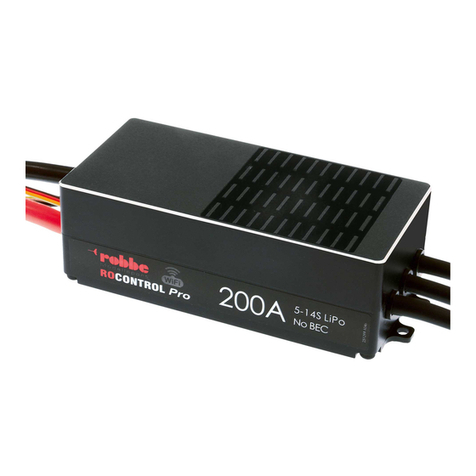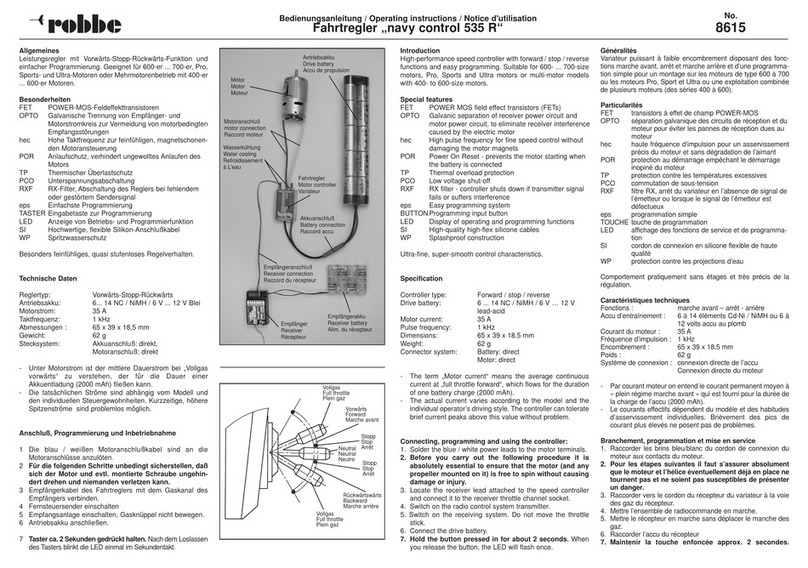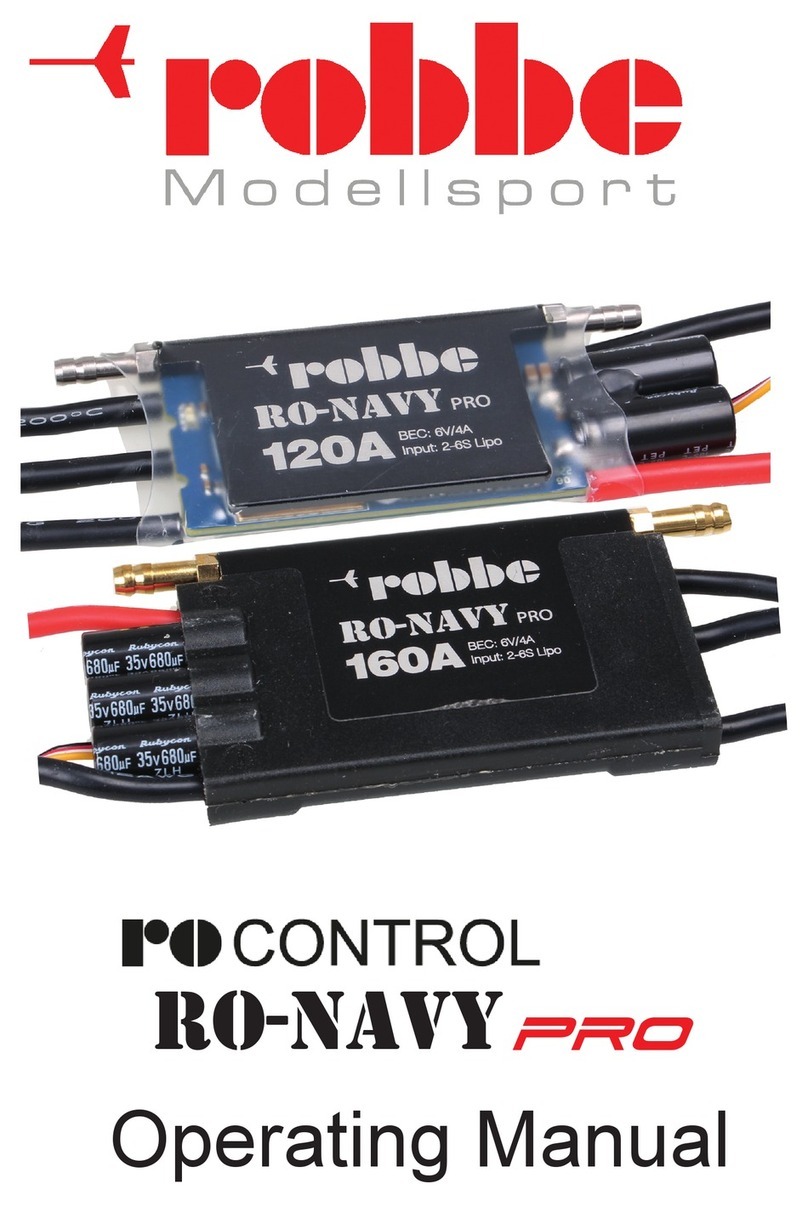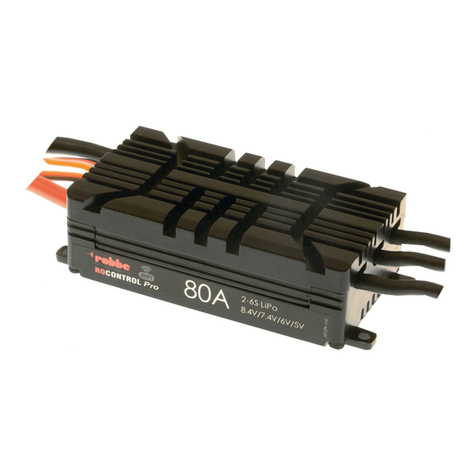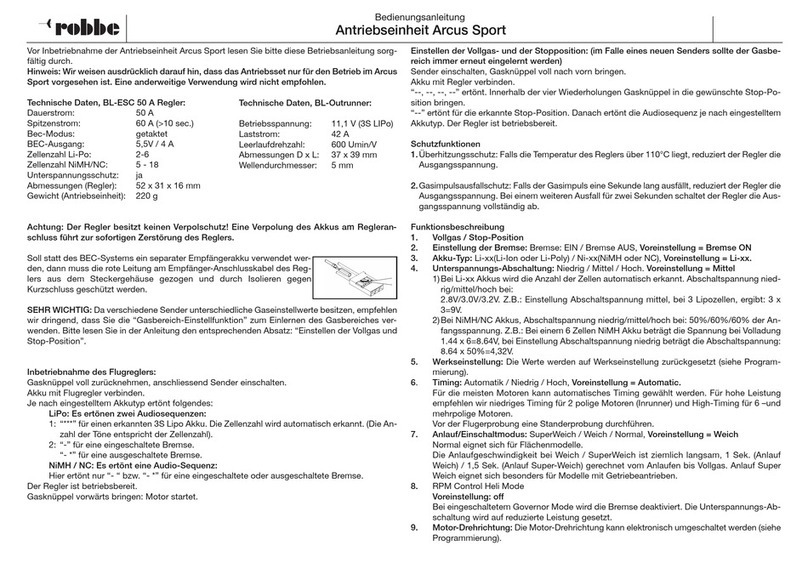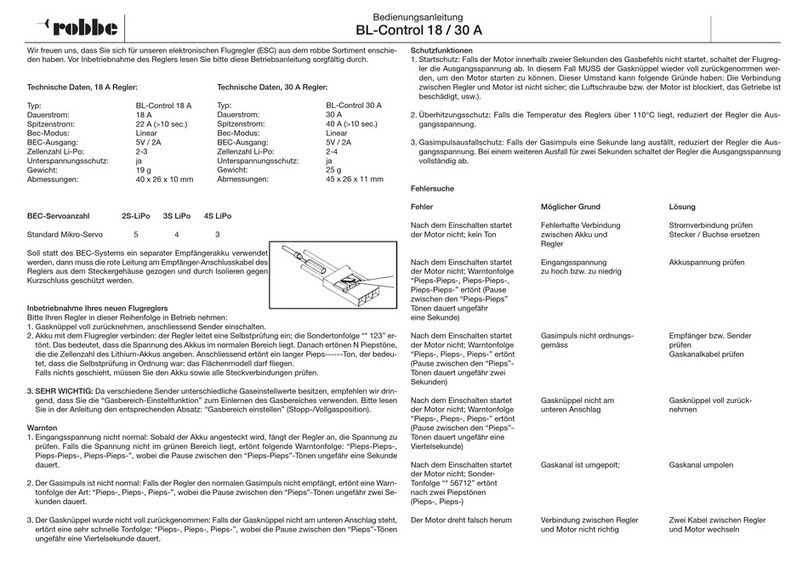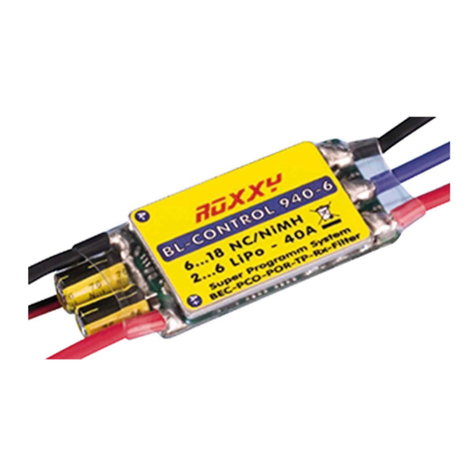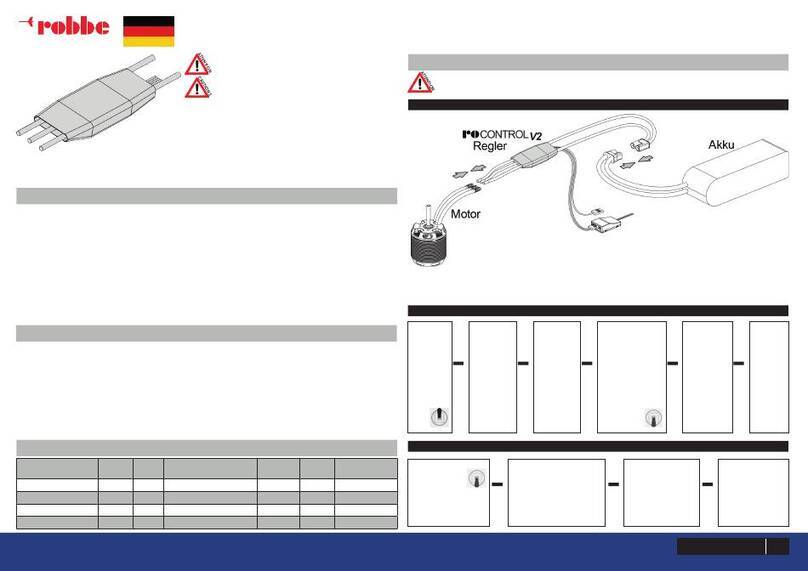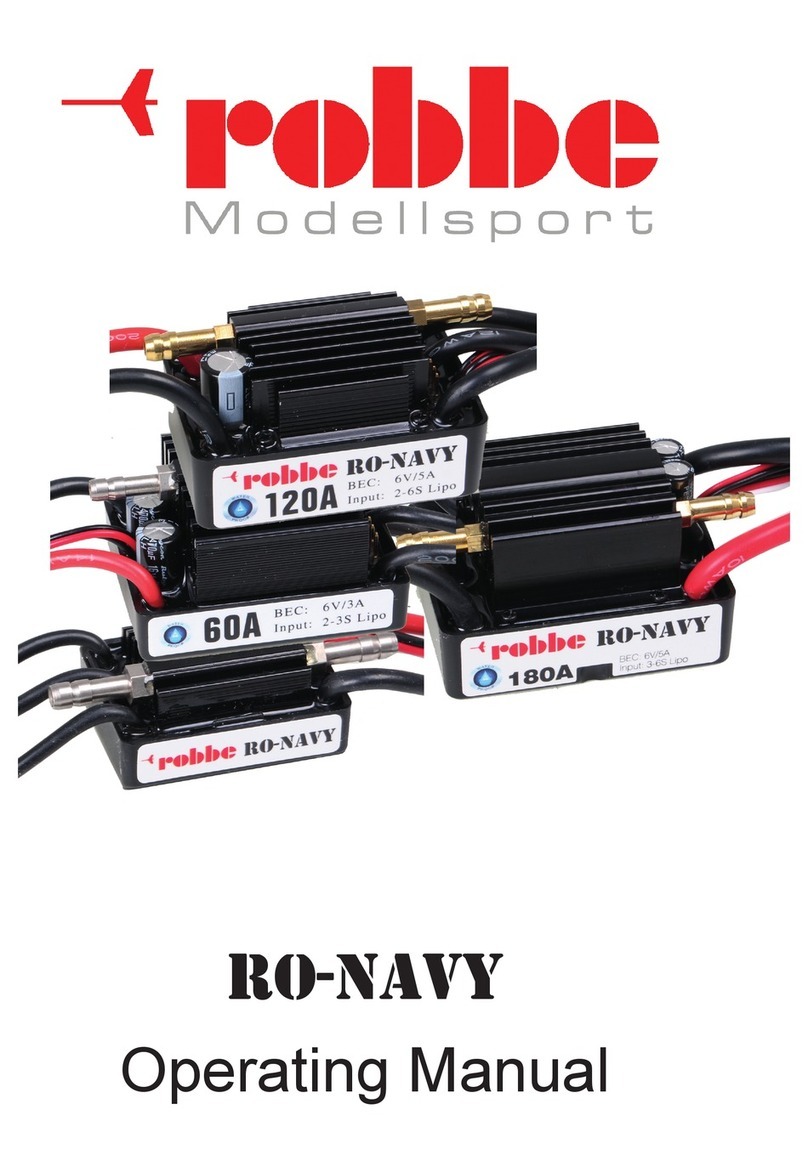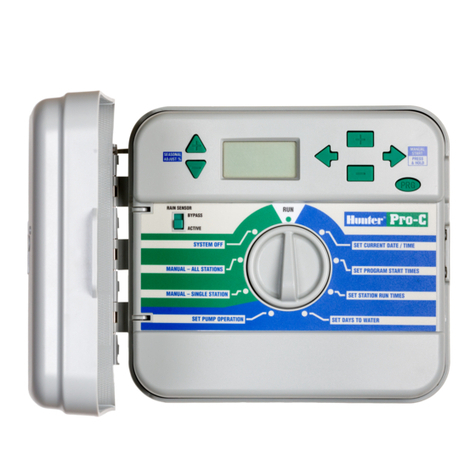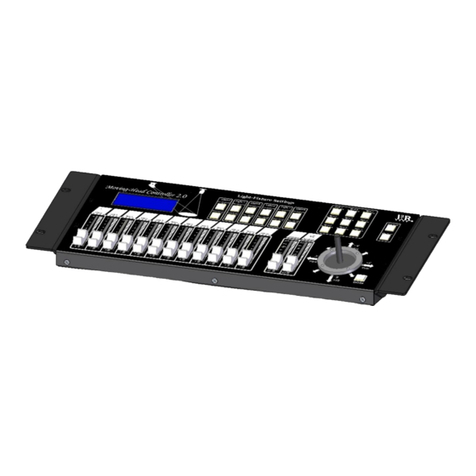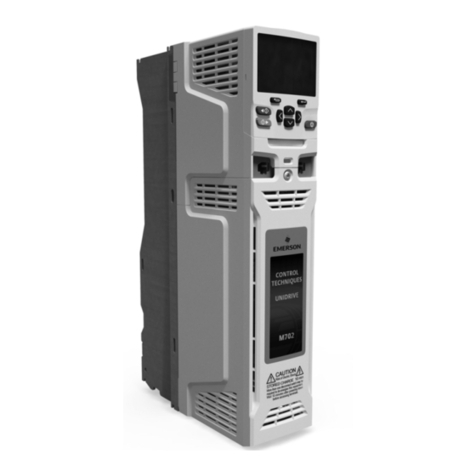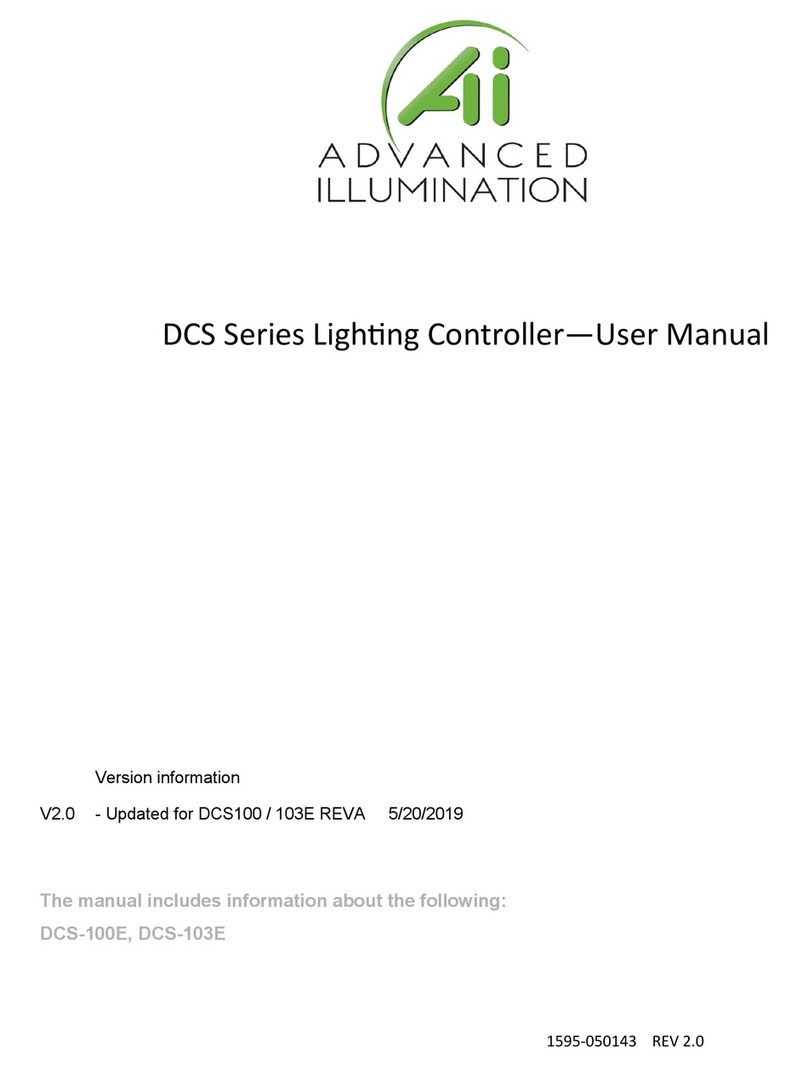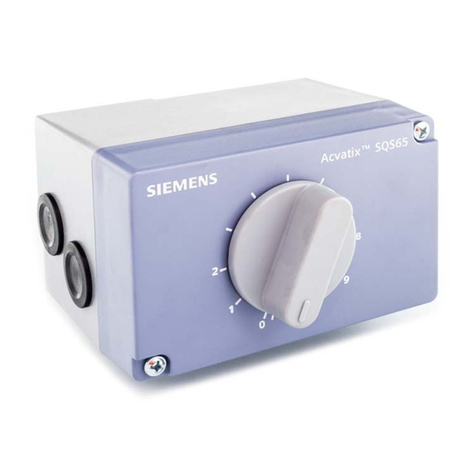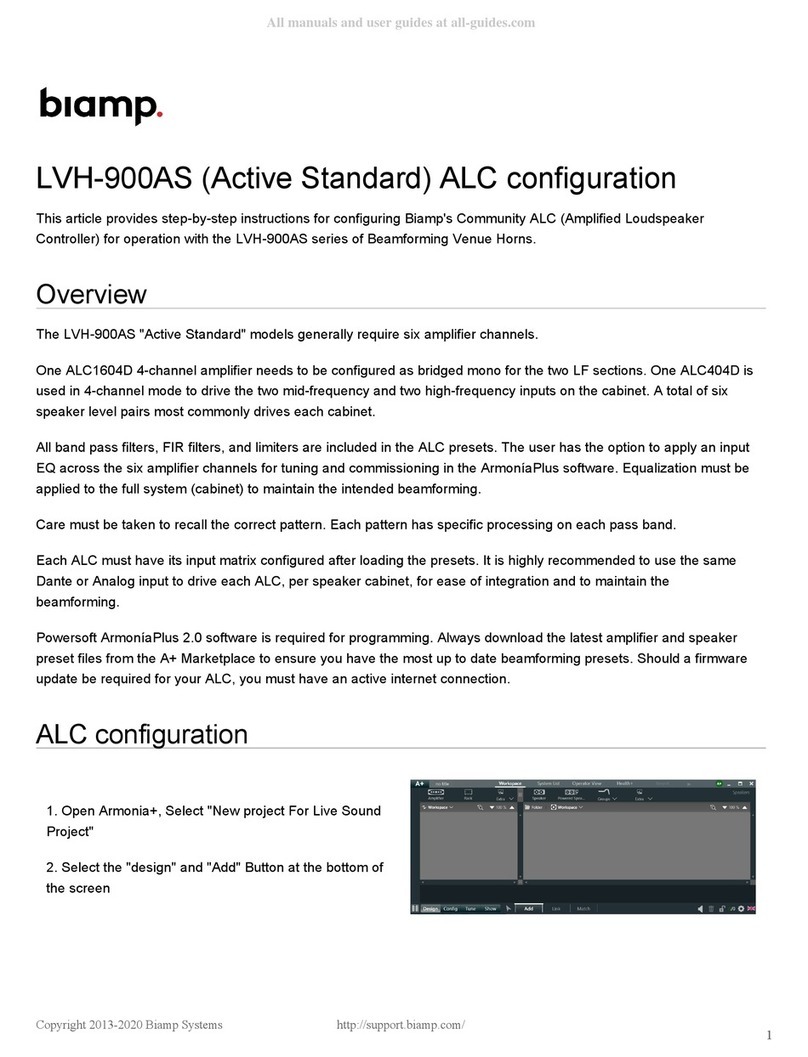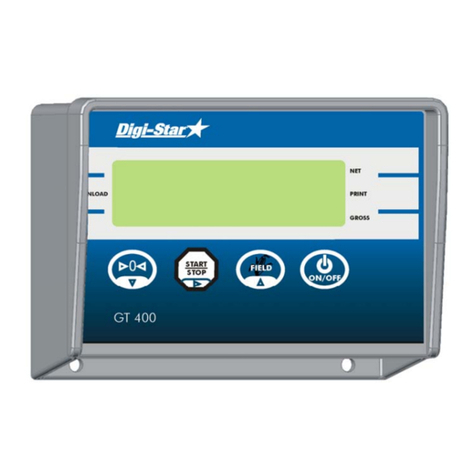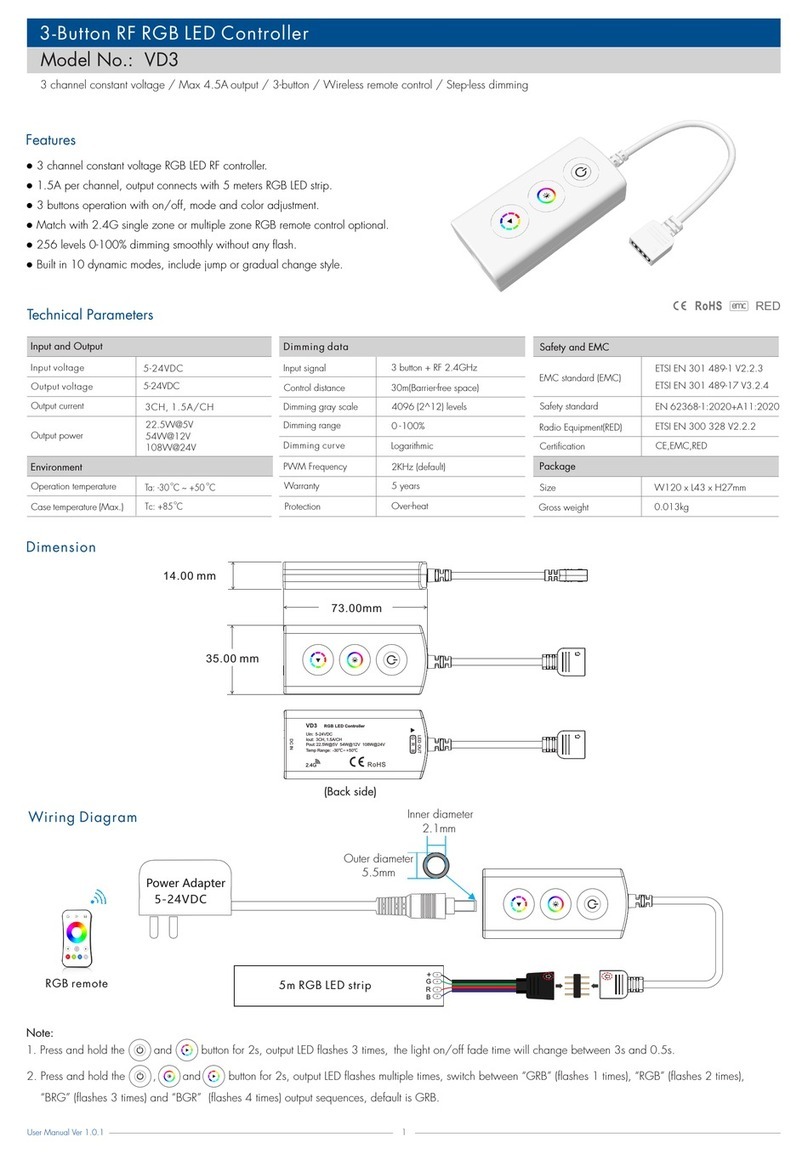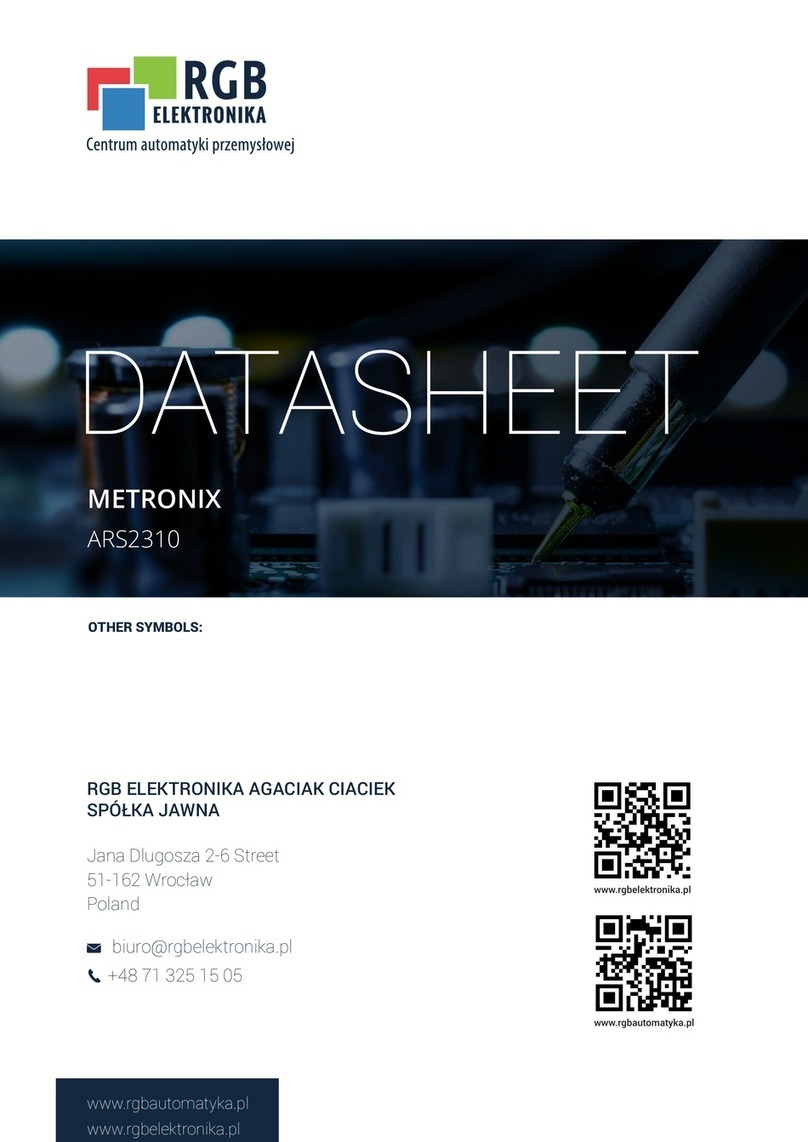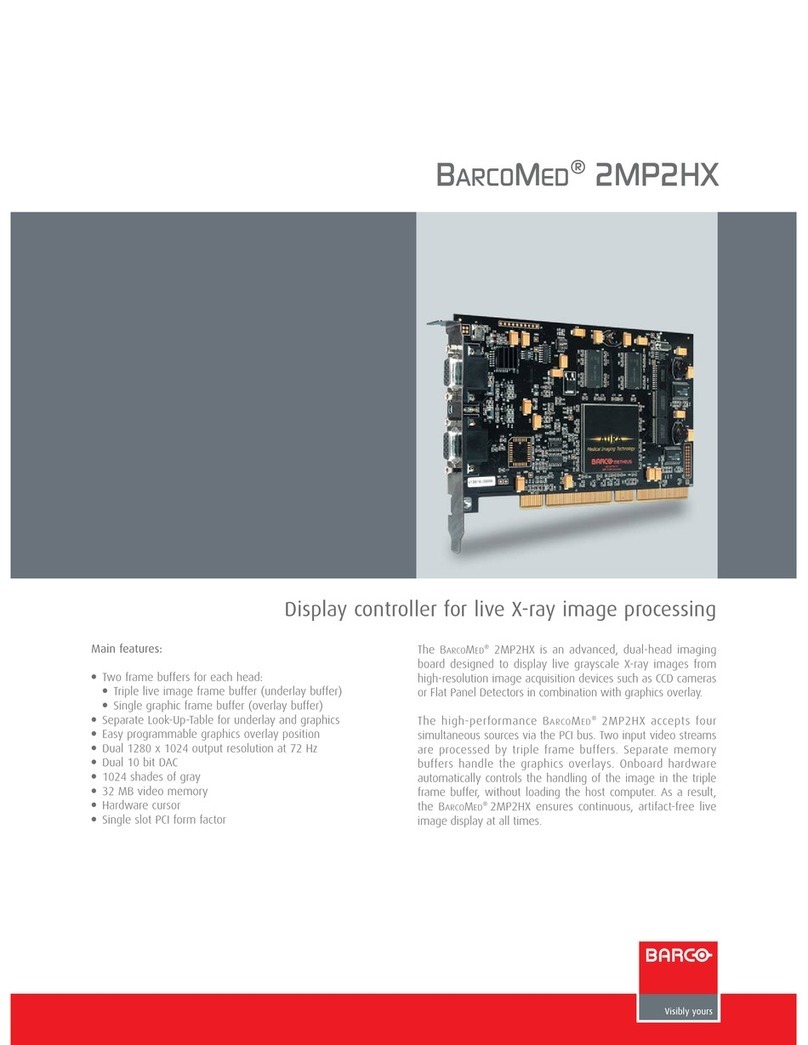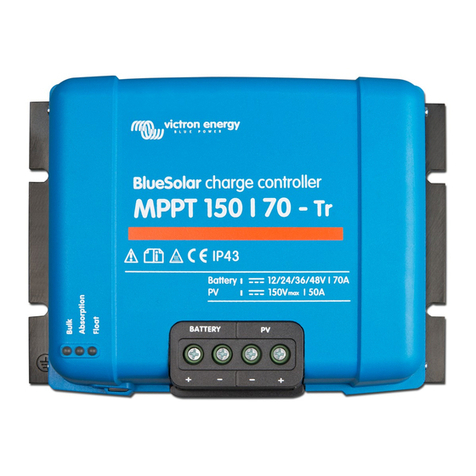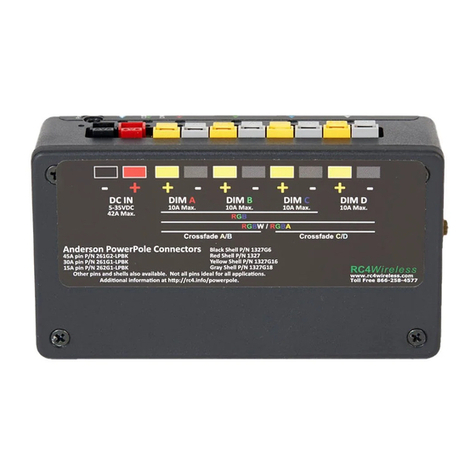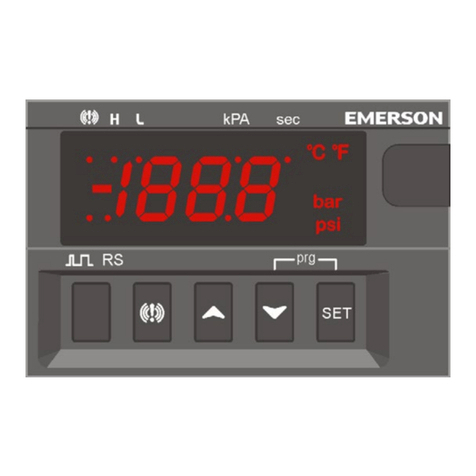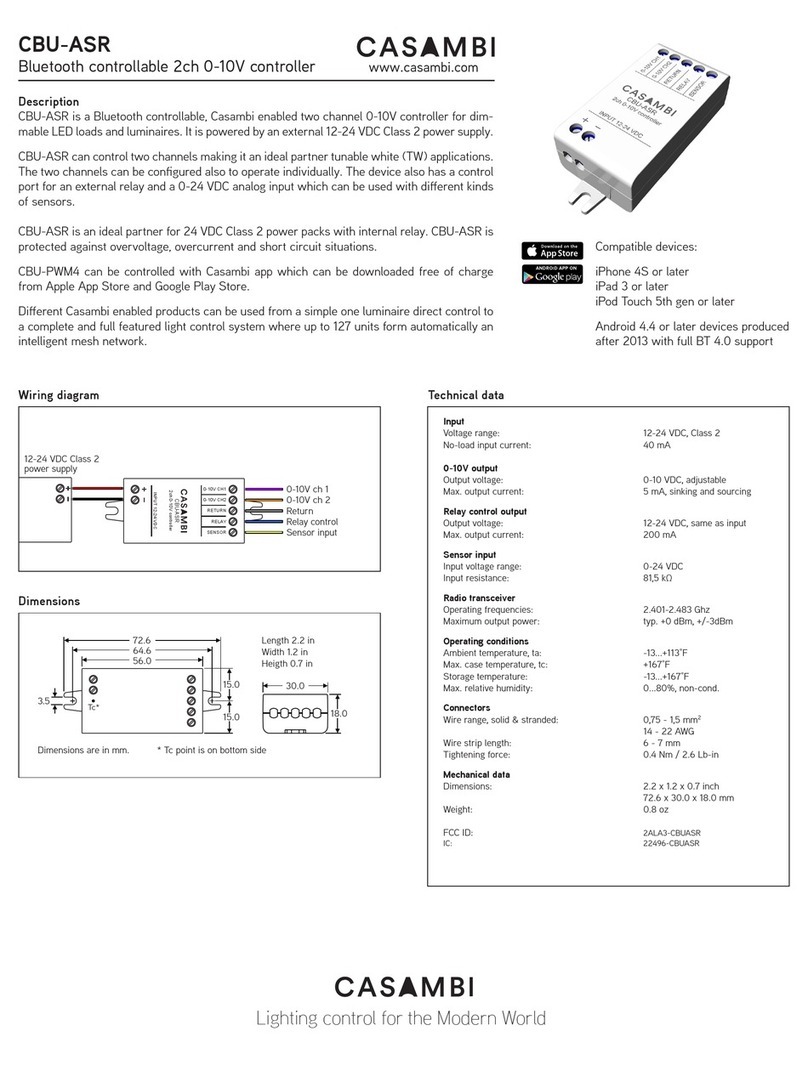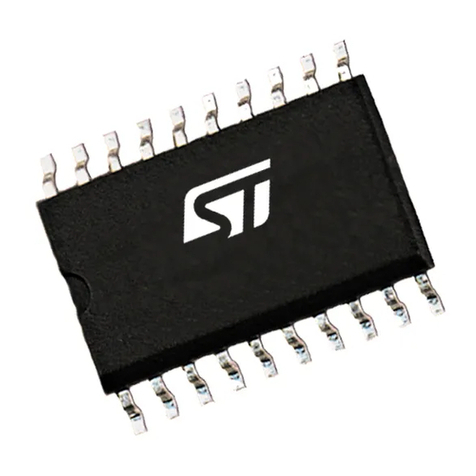
No.
8400, 8401, 8402
Bedienungsanleitung / Operating instructions / Notice d'utilisation
Mikroprozessor - Fahrtregler Rookie 20, 25, 35 WP
Anschluß, erste Inbetriebnahme
- Sender einschalten.
-Rx - Kabel des Reglers am entsprechenden Empfängerkanal
anschließen. Bei Betrieb ohne BEC, rotes Kabel am Reglerstec-
ker herausziehen und Empfängerakku anschließen.
- 5 - 10 NC-Zellen (Fahrakku) anschließen. Unbedingt auf richtige
Polung achten.
- Das Blinken der LED in sehr kurzen Intervallen zeigt die Betriebs-
bereitschaft des Reglers an.
Steuerknüppel langsam hin- und her bewegen.
-Am Fahrtregler wird der Vorwärtsbetrieb durch ein gleichmäßiges
Leuchten, der Rückwärtsbetrieb durch ein Blinken der LED an-
gezeigt. Befindet sich der Gasknüppel in Vorwärtstellung, muß
sich der Fahrtregler im Vorwärtsbetrieb befinden. Trifft dies nicht
zu, ist der Regler neu zu programmieren (siehe
„Programmierung").
- Der Motor muß im Vorwärtsbetrieb des Reglers "vorwärts" lau-
fen, ansonsten die Anschlüsse am Motor vertauschen. Den
Motor nicht im Rückwärtsbetrieb vorwärts laufen lassen, dies
führt zu übermäßiger Belastung des Reglers.
Programmierung
Um in den Programmiermodus zu gelangen, muß die Fahrakkuspan-
nung kurz unterbrochen werden.
- Steuerknüppel nicht bewegen.
- Den Taster solange drücken, bis die LED gleichmäßig 1 mal blinkt.
- Den Knüppel in die Stellung „Vollgas vorwärts“ bringen und Taster
kurz betätigen. Die LED muß zweimal blinken.
- Den Knüppel in Neutralstellung bringen und Taster kurz betätigen.
Die LED muß dreimal blinken.
- Den Knüppel in die „Stellung „Vollgas rückwärts“ bringen. Taster
kurz betätigen.
- Der Regler ist betriebsbereit.
Ist keine Funktion gegeben und die LED blinkt wie beim ersten
Schritt, die Programmierung (evtl. mit anderen Knüppelstellungen)
wiederholen.
Hinweis: Wird beim Programmieren die Neutralstellung mit einem
Doppelklick auf den Taster bestätigt, sind Rückwärts- und Brems-
funktion deaktiviert. Der Regler arbeitet nur im Vorwärtsbereich.
Der Regler ist nach Anschluß des Fahrakkus, länger anhaltenden
Funkstörungen, Unterspannungsabschaltung oder Temperaturab-
schaltung nicht mehr betriebsbereit.
Durch Wechsel der Gasknüppelpositionen (z. B. Vorwärts -
Rückwärts) wird dieser Zustand aufgehoben.
Sicherheitshinweise
- Technische Daten des Reglers beachten
- Akku nicht verpolen
- Kurzschlüsse der Kabel unbedingt vermeiden
- Antriebsmotor wirkungsvoll entstören
- Auf gute Luftzirkulation achten.
- Den Regler so einbauen bzw. verpacken, daß er nicht mit Fett
oder Öl in Berührung kommen kann.
robbe Modellsport GmbH & Co. KG
Technische Änderungen vorbehalten
Copyright robbe-Modellsport 2005
"S"
Motoranschluß
motor connection
Raccord moteur
Empfängeranschluß
Receiver connection
Raccord récepteur
Akkuanschluß
Battery connection
Raccord accu
LED
Fahrtregler
Motor con-
troller
Variateur
Motor
Motor
Moteur
Empfänger
Receiver
Récepteur
Fahrakku
Drive battery
Accu de propulsion
Akkuanschluß
rot = +, schwarz =-
Battery connection
red = +, black =-
Raccordaccu
rouge = +, noir =-
Motoranschluß
motor connection
Raccord moteur
Empfängeranschluß
Receiver connection
Raccord du récep-
teur
TASTER
Button
Touche
Neutralposition
Neutral
Neutre
Brems- / Rückwärtsbereich
Brake / reverse range
Zone de freinage / marche
arrière
Vorwärtsbereich
Forwards range
Zone de marche avant
Branchement, première mise en service
- mettre l’émetteur en marche
- raccorder le fil Rx à la voie correspondante du récepteur. Si le
système fonctionne sans BEC, retirer le brin rouge du con-
necteur du variateur et raccorder l’accu du récepteur.
- raccorder l’accu de 5 à 10 éléments Cd-Ni (accu du moteur).
Attention à la polarité.
- le fait que la LED clignote avec de très courts intervalles indique
que le variateur est en ordre de marche
- déplacer lentement le manche de l’avant vers l’arrière
- sur le variateur, la marche avant est indiquée par le fait que la
LED est allumée en permanence alors que la LED clignote en
marche arrière. Lorsque le manche des gaz se trouve en marche
avant, il faut que le variateur se trouve également en marche
avant. Si ce n’est pas le cas, reprogrammer le variateur (cf.
„Programmation“)
- lorsque le variateur se trouve en marche avant, le moteur doit
tourner en marche avant sinon, inverser les connexion du
moteur. Ne pas laisser tourner l moteur en marche arrière alors
que le variateur est en marche avant, le variateur subit une
charge excessive.
Programmation
Pour accéder au mode programmation, il faut interromprebriève-
ment la tension de l’accu du moteur.
- ne pas déplacer le manche d’asservissement
-presser sur la touche jusqu’à ce que la LED clignote régulière-
ment 1 fois
-amener le manche des gaz en position „plein gaz avant“ et
presser brièvement sur la touche. La LED doit clignoter deux fois
-amener le manche au neutre et appuyer brièvement sur la
touche. La LED doit clignoter trois fois
-amener le manche en position „plein gaz arrière“. Appuyer
brièvement sur la touche
- le variateur est en ordre de marche.
En l’absence de fonction alors que la LED clignote comme pour la
première étape mentionnée, reprendre la programmation (si néces-
saire avec une autre programmation des manches).
À noter:lorsque la programmation du neutre est confirmée par un
double clic sur la touche, la marche arrière et le frein ne sont plus
efficaces. Le variateur ne travaille qu’en marche avant.
Après avoir raccordé l’accu du moteur, en présence de longs
dérangements de transmission et commutation de sous-tension ou
commutation du fait de température excessive, le variateur n’est
plus en ordre de marche.
Une modification de la position du manche des gaz (par ex. marche
avant - marche arrière) permet de supprimer cet état.
Conseils de sécurité
-tenir compte des caractéristiques techniques du variateur
-ne pas inverser les polarités de l’accu
- éviter absolument de mettre les brins en court-circuit
- antiparasiter efficacement le moteur
-veiller à ce que l’air circule correctement
-installer ou emballer le variateur de telle manière qu’il ne puisse
pas entrer en contact avec de la graisse ou de l’huile.
robbe Modellsport GmbH & Co. KG
Sous réserve de modification technique
Connecting the controller, using the system for the first time
-Switch on the transmitter.
-Connect the Rx cable attached to the controller to the appropri-
ate receiver channel. If you are not using the BEC system pull
out the red wire from the controller plug, insulate the end and
connect a separate receiver battery.
-Connect the 5 - 10 cell NC pack (drive battery). It is essential to
maintain correct polarity.
-Move the throttle stick slowly forward and back.
-The LED will glow steadily when in the “forwards” range. In
“reverse” the LED will flash. When the throttle stick is in the “for-
wards” part of its arc the speed controller must be in the “for-
wards” range. If this is not the case the controller needs to be re-
programmed (see “Programming”).
-When the controller is in the “forwards” range the motor must
also run in the direction corresponding to the model’s forward
motion. If not, swap over the connections at the motor terminals.
Do not leave the system “the wrong way round”, i.e. the motor
running forwards when the controller is in reverse mode, as
this overloads the controller.
Programming
- To enter programming mode the drive battery voltage must be
disconnected briefly.
- Leave the throttle stick untouched.
-Hold the push-button pressed in until the LED flashes once
evenly.
-Move the stick to the “full throttle forwards” position and press
the button briefly. The LED should now flash twice.
-Move the stick to the neutral position and press the push-button
again. The LED should now flash three times.
-Move the stick back to the “full throttle reverse” position and
press the push-button again.
-The speed controller is now completely set up and ready to work.
If the controller does not appear to work and the LED flashes at the
first stage of programming, repeat the programming procedure (you
may find that different stick positions work better).
Note: You can disable the reverse and brake functions by giving a
double-press on the push-button when programming the neutral po-
sition. The controller now works over the forwards range only.
The controller will not work under the following conditions: immedi-
ately after you connect the drive battery, after a prolonged period of
radio interference, and after the low-voltage circuit or the excess
temperature circuit have tripped.
You can re-activate the controller by altering the throttle stick posi-
tion (e.g. forwards - reverse).
Safety notes
-It is important to stay within the parameters listed in the Specifi-
cation.
-Do not connect the battery with reverse polarity.
- Take care to avoid short-circuits between the various cables.
-Provide adequate interference suppression for the electric motor.
-Provide good air circulation to the controller.
-Install the unit in such a way that it cannot come into contact with
grease or oil.
robbe Modellsport GmbH & Co. KG
We reserve the right to alter technical specifications




